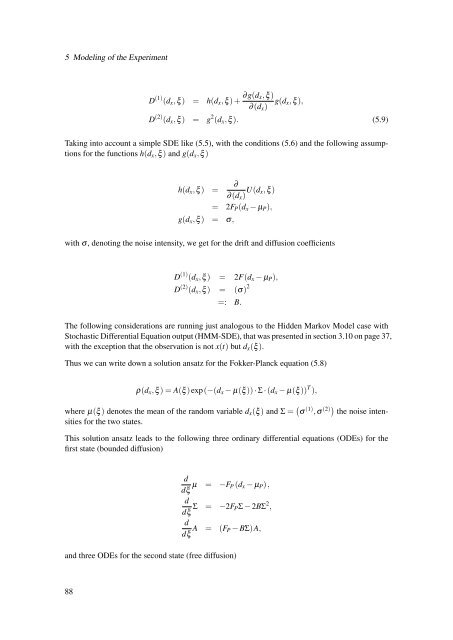Diffusion Processes with Hidden States from ... - FU Berlin, FB MI
Diffusion Processes with Hidden States from ... - FU Berlin, FB MI
Diffusion Processes with Hidden States from ... - FU Berlin, FB MI
You also want an ePaper? Increase the reach of your titles
YUMPU automatically turns print PDFs into web optimized ePapers that Google loves.
5 Modeling of the ExperimentD (1) (d x ,ξ ) = h(d x ,ξ ) + ∂g(d x,ξ )g(d x ,ξ ),∂(d x )D (2) (d x ,ξ ) = g 2 (d x ,ξ ). (5.9)Taking into account a simple SDE like (5.5), <strong>with</strong> the conditions (5.6) and the following assumptionsfor the functions h(d x ,ξ ) and g(d x ,ξ )h(d x ,ξ ) =∂∂(d x ) U(d x,ξ )= 2F P (d x − µ P ),g(d x ,ξ ) = σ,<strong>with</strong> σ, denoting the noise intensity, we get for the drift and diffusion coefficientsD (1) (d x ,ξ ) = 2F(d x − µ P ),D (2) (d x ,ξ ) = (σ) 2=: B.The following considerations are running just analogous to the <strong>Hidden</strong> Markov Model case <strong>with</strong>Stochastic Differential Equation output (HMM-SDE), that was presented in section 3.10 on page 37,<strong>with</strong> the exception that the observation is not x(t) but d x (ξ ).Thus we can write down a solution ansatz for the Fokker-Planck equation (5.8)ρ(d x ,ξ ) = A(ξ )exp(−(d x − µ(ξ )) · Σ · (d x − µ(ξ )) T ),where µ(ξ ) denotes the mean of the random variable d x (ξ ) and Σ = ( σ (1) ,σ (2)) the noise intensitiesfor the two states.This solution ansatz leads to the following three ordinary differential equations (ODEs) for thefirst state (bounded diffusion)ddξ µ = −F P (d x − µ P ),ddξ Σ = −2F PΣ − 2BΣ 2 ,ddξ A = (F P − BΣ)A,and three ODEs for the second state (free diffusion)88









